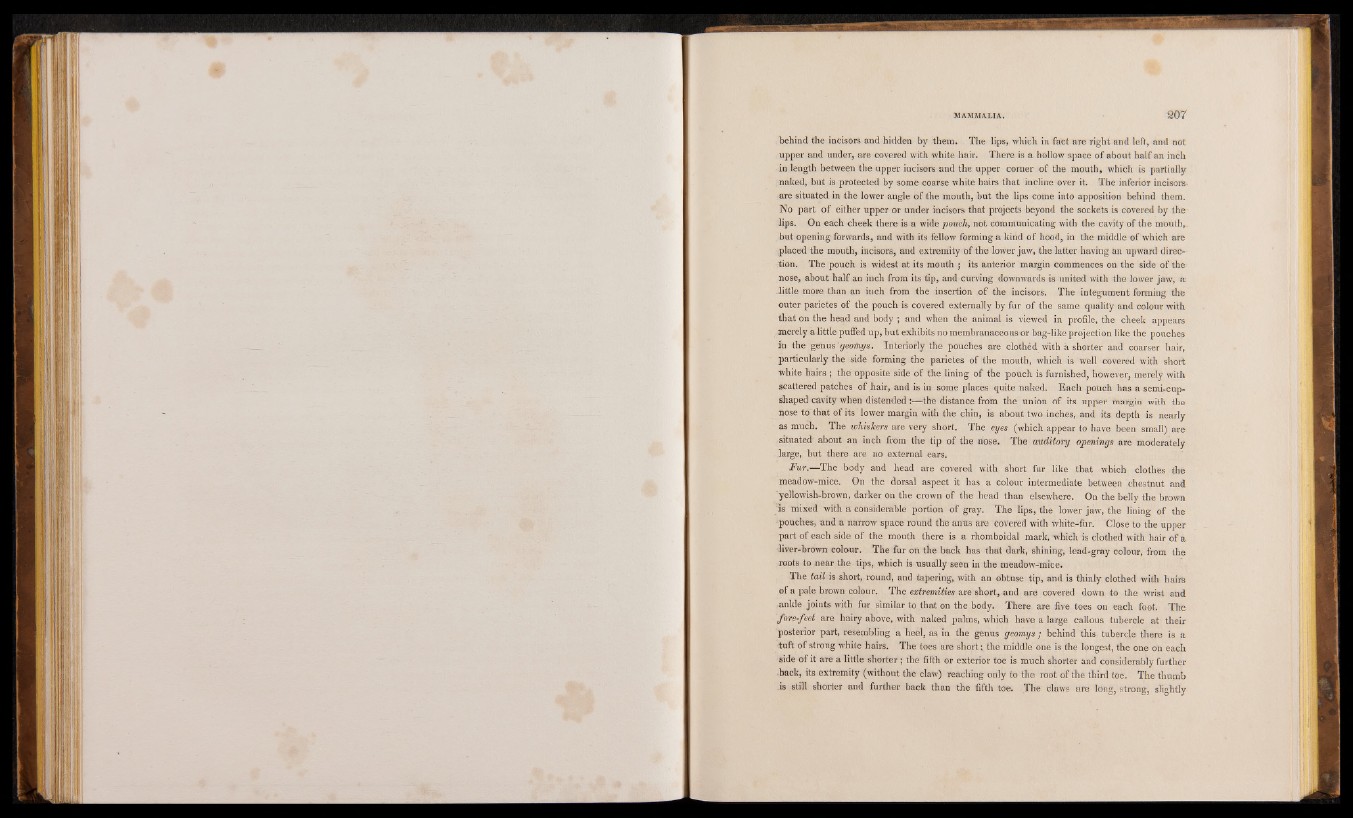
MAMMALIA. 207
behind the incisors and hidden by them. The lips, which in fact are right and left, and not
upper and under, are covered with white hair. There is a hollow space of about half an inch
in length between the upper incisors and the upper corner of the mouth, which is partially
naked, but is protected by some coarse white hairs that incline over it. The inferior incisors^
are situated in the lower angle of the mouth, but the lips come into apposition behind them.
No part of either upper or under incisors that projects beyond the sockets is covered by the
lips. On each cheek there is a wide pouch, not communicating with the cavity of the mouthy
but opening forwards, and with its fellow forming a kind of hood, in the middle of which are
placed the month, incisors, and extremity of the lower jaw, the latter having an upward direction.
The pouch is widest at its mouth ; its anterior margin commences on the side of the
nose, about half an inch from its tip, and curving downwards is united with the lower jaw, a
Jittle more than an inch from the insertion of the incisors. The integument forming the
outer parietes of the pouch is covered externally by fur of the same quality and colour with
that on the head and body ; and when the animal is viewed in profile, the cheek appears
merely a little puffed up, but exhibits no membranaceous or bag-like projection like the pouches
in the genus geofnys. Interiorly the pouches are clothéd with a shorter and coarser hair,
particularly the side forming the parietes of the mouth, which is well covered with short
white hairs ; the opposite side of the lining of the pouch is furnished, however, merely with
scattered patches of hair, and is in some places quite naked. Each pouch has a semi-cupshaped
cavity when d isten d ed -th e distance from the union of its upper margin with the
nose to that of its lower margin with the chin, is about two inches, and its depth is nearly
as much. The whiskers are very short. The eyes (which appear to have been small) are
situated about an inch from the tip of the hose. The auditory openings are moderately
large, but there are no external ears.
Fur.—The body and head are covered with short fur like that which clothes the
meadow-mice. On the dorsal aspect it has a colour intermediate between chestnut and
yellowish-brown, darker on the crown of the head than elsewhere. On the belly the brown
is mixed with a considerable portion of gray. The lips, the lower jaw, the lining of the
pouches, and a narrow space round the anus are covered with white-fur. Close to the upper
part of each side of the mouth there is a rhomboidal mark, which is Clothed with hair of a
liver-brown colour. The fur oft the back has that dark, shining, lead-gray colour, from the
roots to near the tips, which is usually seen in the meadow-mice.
The tail is short, round, and tapering, with an obtuse tip, and is thinly clothed with hair's
of a pale brown colour. The extremities are short, and are covered down to the wrist and
-ankle joints with fur similar to that on the body. There are five toes on each foot. The
fore-feet are hairy above, with naked palms, which have a large callous tubercle at their
posterior part, resembling a heel, as in the genus geomys ; behind this tubercle there is a
tuft of strong while hairs. The toes are short; the middle one is the longest, the one on each
side of it are a little shorter ; the fifth or exterior toe is much shorter and considerably further
hack, its extremity (without the claw) reaching only to the root of the third toe. The thumb
.is still shorter and further back than the fifth toe. The claws are long, strong, slightly